|
The Leather
Industry

An advert from 1851.
Most leather work was originally
carried out in small workshops, usually by men, often in a
yard behind a house. Most businesses were small, employing
between one and three people. All that was required to carry
out the work was a few inexpensive hand tools such as
hammers, knives, pincers, and a pricking iron. Curriers used
a two handled knife to shave the leather to the required
thickness. Most of the tools were produced in the town so
that Walsall’s leather trade became almost self-sufficient.
By the middle of the 19th century,
leather factories had appeared, which employed men, women
and children. Within twenty years large numbers of women
worked in the industry. In the late 1860s around sixty
percent of the workforce in bridle and harness making were
women, and around thirty percent of saddlery workers were
women. The development of the sewing machine in the 1850s
greatly changed manufacturing. It led to larger workshops,
and increased production.
In the 19th century the industry
thrived because of the expanding number of working horses in
Britain, and an increasing demand for saddlery and harnesses
from abroad, particularly from the USA, India, Australia,
New Zealand, and South America. The local factories
benefited greatly by the coming of the railways, which
enabled products to be quickly and efficiently sent to
destinations all over the country, including sea ports where
goods could be loaded onto ships for export.
William White lists the following
leather goods manufacturers in his Staffordshire directory
of 1851:
|
| 19 |
|
Bridle cutters |
| 57 |
|
Saddle, harness, and collar
manufacturers |
| 7 |
|
Whip thong makers |
| 14 |
|
Curriers and leather sellers |
| |
|
|
| |
|
Allied industries |
| 19 |
|
Stirrup manufacturers |
| 4 |
|
Spur rowel makers |
| 19 |
|
Spur manufacturers |
| 6 |
|
Saddle tree makers |
| 3 |
|
Saddlers’ tool makers |
| 27 |
|
Saddlers’ ironmongers |
| 2 |
|
Saddle nail makers |
| 12 |
|
Buckle tongue makers |
| 38 |
|
Buckle makers |
| 47 |
|
Bit makers |
| 8 |
|
Hame and harness iron makers |
|

An advert from 1865.
|
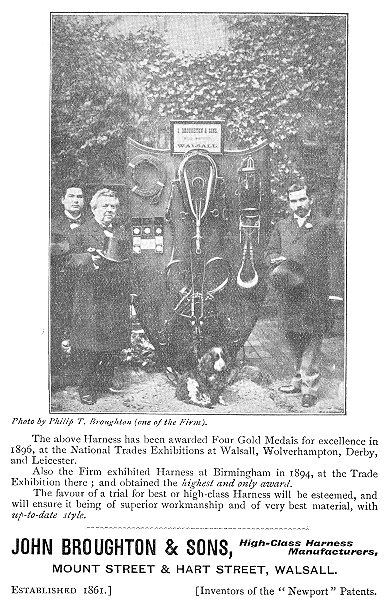
An advert from 1899. |
After 1870 the leather manufacturers
suffered because of competition from Germany, and falling
markets in Europe.
Another threat was the introduction of
the motor car. The innovative industry responded by turning
to the production of bicycle saddles, and upholstery, and
fancy leatherwork for motor cars.
Some of the old saddle
makers and harness makers began to produce sports equipment
and travel goods. Other manufacturers began to produce bags,
purses, cigar cases, dog collars, and fancy leather, often
for export.
By 1910 there were eight tanneries and twenty
seven curriers in the town which employed several hundred
men. Leather was produced for shoes, cycle and motorcycle
saddles, motor cars.
One well known company, Boak, on the
corner of Bridgeman Street and Station Street was producing
fancy leather from calf, sheep, and goatskins. |
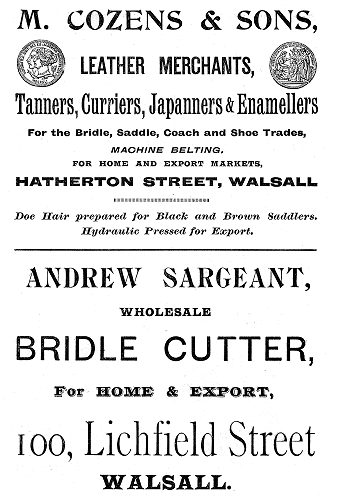 |
|
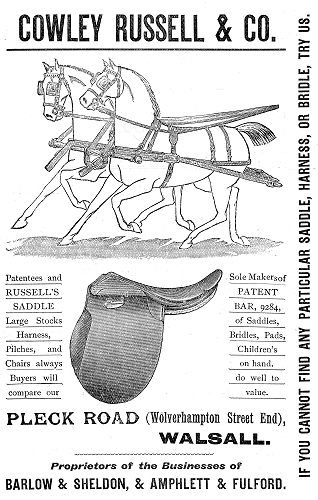 |
|
Two adverts from 1899. |
|
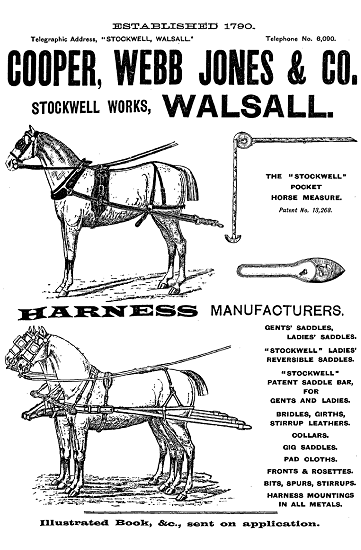 |
|
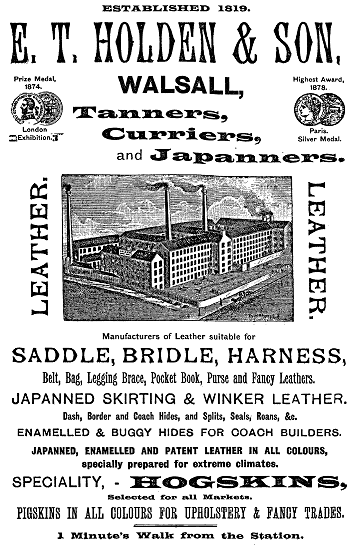 |
|
Messrs. E. T.
Holden and Son, Tanners,
Curriers, and Japanners
A visit to the works in 1897 by
members of the Institution of
Mechanical Engineers
This firm is one
of the largest in the kingdom
for the production of leather,
required for the manufacture of
saddlery and harness, for
upholstery, for coach building,
and for other purposes. It was
founded in 1819 by the late Mr.
E. Holden, whose son is the
present senior partner.
The
manufactory and warehouse are
situated in Park Street, and are
reached through a narrow passage
adjoining the New Inns. What
forty years ago were only one or
two curriers' shops are now the
largest works of the kind in
Walsall; the latest additions
are lofty five-storey buildings.
They comprise offices,
warehouses, depots for hides in
various stages of manufacture,
including scouring shops with a
large scouring drum; compo
houses, with ingenious
mechanical appliances; splitting
shops; finishing rooms;
extensive drying sheds; rooms
and sheds for polishing, for
storage of oil, etc.; also
blacksmiths' and carpenters'
shops.
Here are
produced all kinds of enamelled
and japanned leather, harness
hides, legging hides, horse
hides, leather for military
belts, winkers, bridles, reins,
stirrups, bags, braces, straps,
and fancy articles. A branch of
manufacture requiring most
careful attention is that of
hogskins for racing saddles, for
which lightness is so important
a consideration. The tan yard is
in Beith, Scotland. The goods
are sent from Walsall to London
and the provinces, and also to
the continent and the colonies. |
|
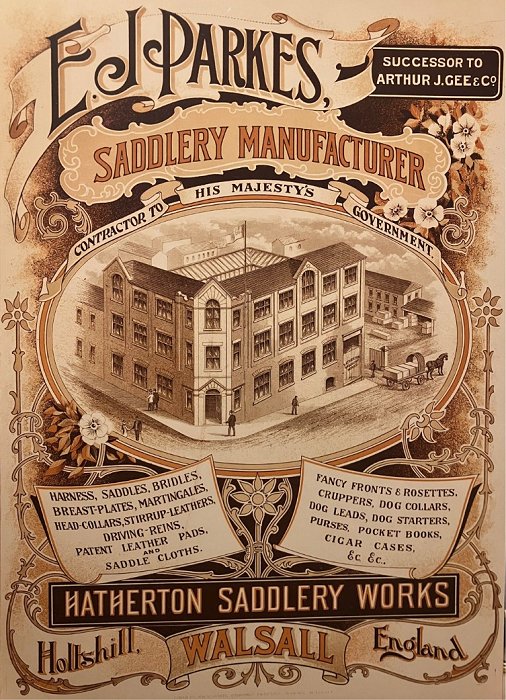
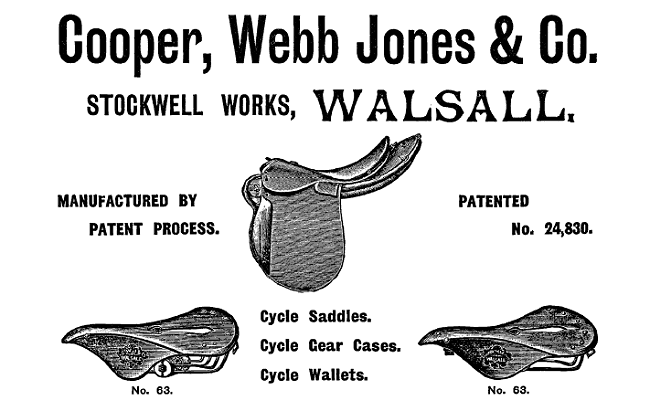
An advert from 1896.

An advert from 1896.
|
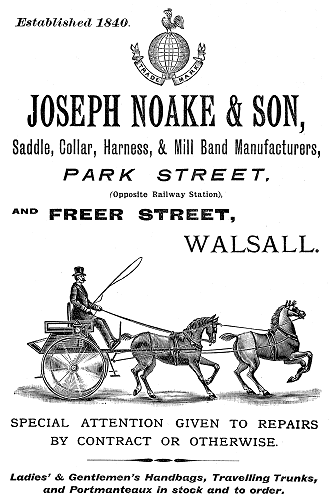
An advert from 1899. |
Fancy leather goods produced in the
early 20th century included blotters, footballs, garters,
gloves, ladies' fancy bags, pocket books, razor strops, and
watch guards.
Around this time the cutting-out process was
mechanised and several large businesses merged.
During the First World War the
factories turned to munitions work, and after the war
Walsall became one of the most important centres for the
production of fancy, and light leather goods in the country.
|
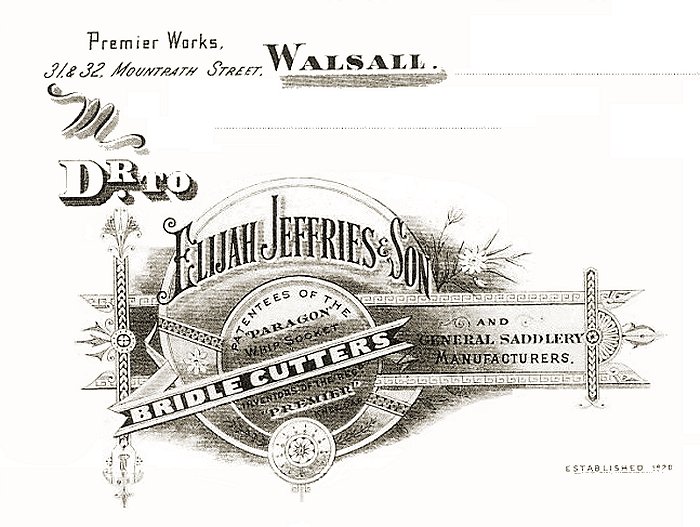
A bill head from 1892.

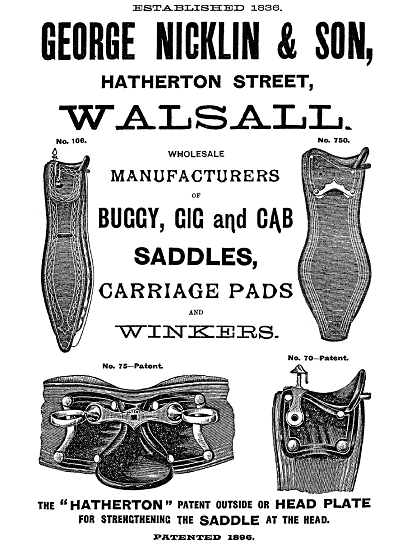
An advert from 1896.

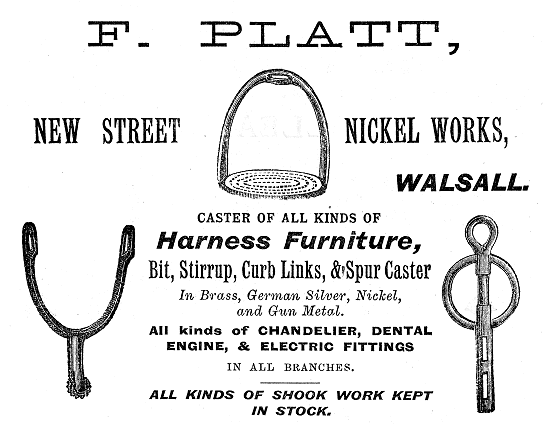
An advert from 1899.
| An advert from 1899. |
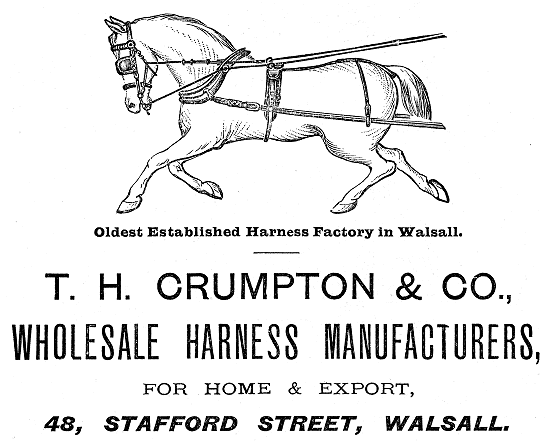 |
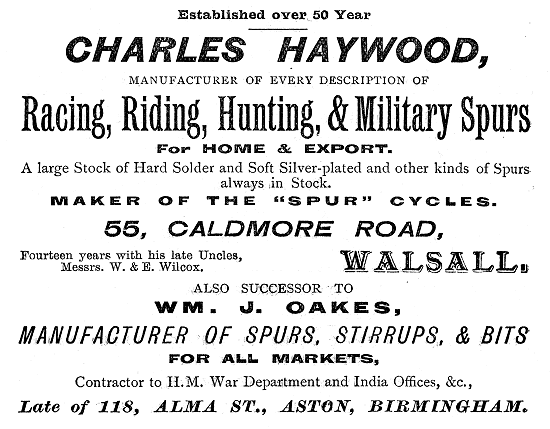 |
An advert from 1899. |
| An advert from 1899. |
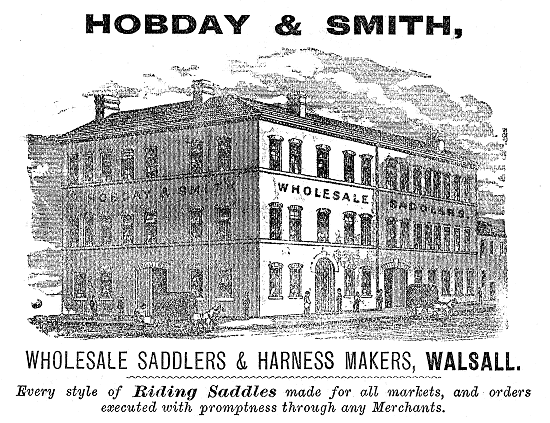 |
 |
An advert from
1899. |
| An advert from
1899. |
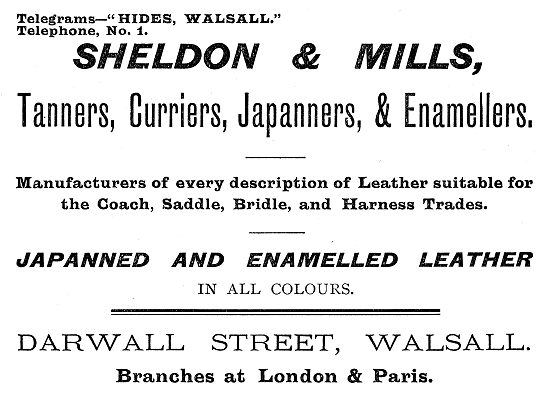 |
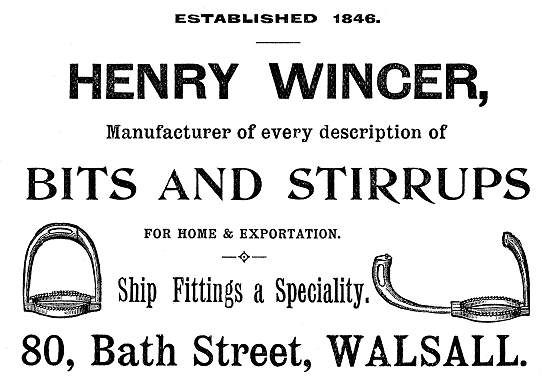 |
An advert from
1899. |
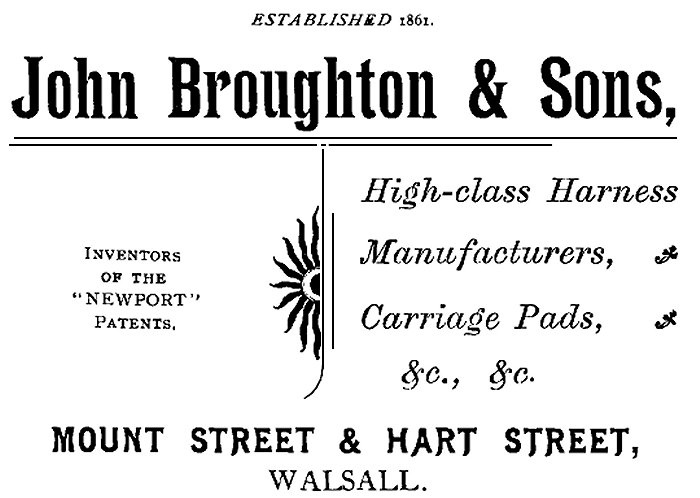
An advert from 1902.
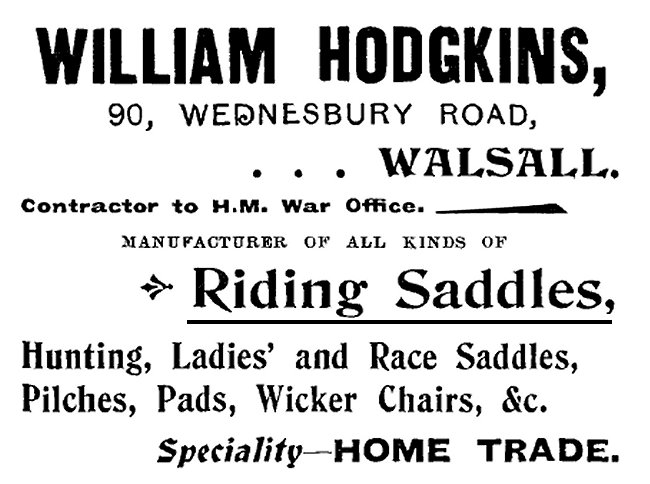
An advert from 1904.
|
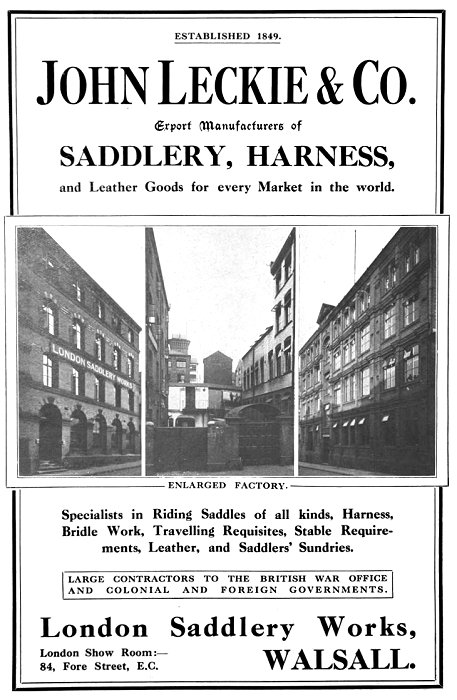
An advert from 1916. |
John Leckie & Company made saddles
and leather goods at London Saddlery Works in
Goodall Street.
The firm also had London showrooms at
84 Fore Street.
Products included saddles and harness, fancy
leather goods, bags, cases, waist belts,
leggings, leather scout and girl guide
equipment, and footballs, which were sold at
home and abroad. |
|
Messrs. John Leckie
and Company, Saddlery and Harness
Works
A visit to the works in 1897 by
members of the Institution of
Mechanical Engineers
Walsall is
chiefly noted as a saddlery town,
and has become the centre of this
industry. The export manufacturing
business of this firm, founded
nearly fifty years ago, was
transferred from Glasgow to Walsall
about twenty-five years ago. It had
been in existence for many years in
Scotland, where a large
manufacturing business for foreign
and colonial trade was carried on;
but owing to the facilities for
obtaining materials, machinery, and
labour in Walsall, it was found more
profitable to transfer the industry
from Scotland. They are the largest
manufacturers in the various
branches of the Walsall leather
industry, ladies' saddles, hunting
saddles, harness, army equipment,
belts, strapping, purses, and every
kind of equestrian requirements for
foreign and colonial travel, which
are all classified and worked under
different departments.
The firm
manufacture their own leather; and
the hides after being tanned are put
through different interesting
processes before they become ready
for use in different colours,
textures, and strengths. In the
cutting room the leather is cut up
by hand or by gauge knives, or is
placed under steam power cutting
presses to be cut out into certain
shapes, until gradually the articles
get their final finish. The work is
prepared for stitching by men and
women; the hand stitching is done in
one department by girls and women,
whilst the plain stitching in most
cases is done in the steam power
machine-rooms, where there are about
thirty machines, of all strengths
and makes, both English and
American, are continually stitching
articles from the lightest to the
heaviest.
After the goods
are stitched and inspected they are
finished and sent down to the
packing rooms, where they are laid
aside under different order numbers
until their respective orders are
completed, when they again undergo
an inspection, after which they are
ready to be packed in cases and sent
by rail to the different ports of
shipment. Among some of the articles
produced here are bandoliers for
South Africa, and eight mule span
harness for the Transvaal, regular
Cape harness for the Colonies,
single harness for the East Indies
and Australia, and mule harness for
the West Indian plantations; whilst
in the saddlery workrooms saddles
are made of all styles, for almost
every foreign market and for the
Colonies, especially South Africa.
In addition, some singularly built
saddles have been made for South
America, with the elevated Somerset
cantles and thigh pads, as well as
some high knee padded saddles for
Australia. For the Kaffirs of the
goldfields and elsewhere hundreds of
grosses of money belts have been
made for their arms, wrists, and
waists. A large amount of work is
done for the government, especially
for India and South Africa. The
number of workpeople employed is
about 300. |
|
|
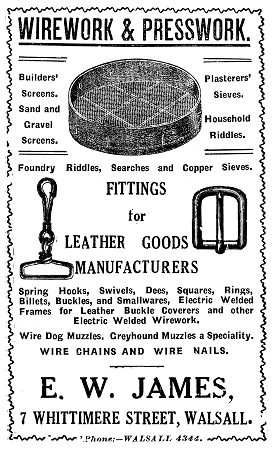
An advert from 1935. |
|
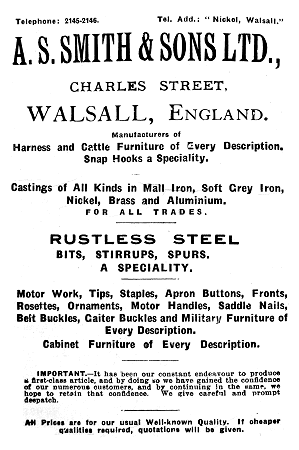
An advert from 1935. |
| |
|
Leather and allied
trades listed
in the 1935 Walsall Red Book |
 |
| |
|
| In the 1950s the industry suffered
because of competition from products made of artificial
leather.
By the 1960s tanning was in decline, but over
600 people still worked in the industry.
In 1970 there were
around 50 leather goods manufacturers in Walsall, and
the town produced around half of the British-made fancy leather
goods.
A small number of saddle and harness
makers survived, producing high quality, hand-made items,
mainly for the top end of the market.
In recent times there
has been a revival in the saddlery trade, which has ensured
that Walsall’s saddle making industry will survive into the
foreseeable future.
More leisure time and televised
equestrian events led to increased interest in horse riding
for pleasure, and a dramatic revival of the quality saddle
making industry. |
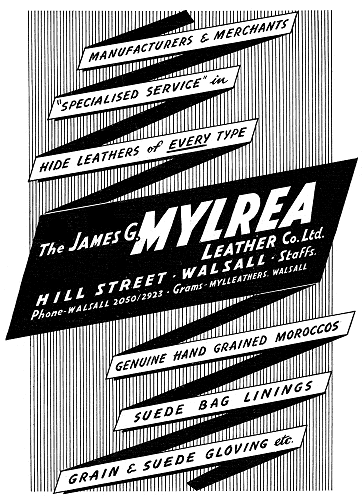
An advert from 1954. |
|
 |
|
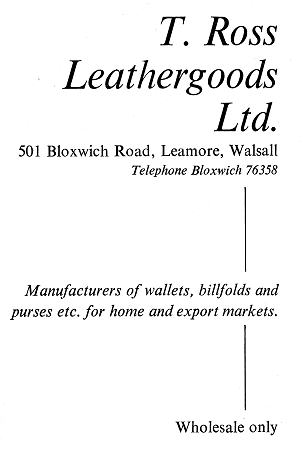 |
|
Two adverts
from 1974. |
|

| Imperial Leather Works
in 1914, premises of Moss, Stone & Company. It
is now occupied by Lovatt & Ricketts, and called
Clifford House. |
|
Moss, Stone & Company of Imperial
Leather Works, Butts Road was founded in 1898 by Mr. Alfred
Moss.
The firm manufactured saddlery of all
kinds and specialised in light saddlery for racing,
steeple-chasing, exercising, and polo, which was used in the
principal races and polo clubs.
Another product, solely manufactured by
the company was the patent ventilated, extremely light
saddle invented by Robson, of York.
In 1913 the company acquired the old
established business of the late Mr. Thomas Ash, Paragon
Works, Walsall, together with the goodwill, patents, trade
marks and manufacturing rights.
The company also produced fancy leather
goods including purses, pocket books, jewel cases, music
cases, camera cases, attache cases, suit cases, watch
guards, wristlets, braces and men's belts, blotters, dog
collars, leads, and dog sheets. |
|
The firm was also a large Government
contractor, making all kinds of military saddlery, harness,
and equipment for the War Office, and patented a side saddle
called the ‘Climax’, and a saddle called the ‘Eldonian’
which was bought by Jeffries in 1987. The London Offices
were at 63, Queen Victoria Street.
Harwood & Sons of Glebe Works, Glebe
Street was founded in 1894 to manufacture high class leather
goods.
Products included American and English
buggy saddles, harness collars, coupé saddles, rein holders,
winkers, pad cloths, letter cases, purses, ladies' bags, dog
collars, belts etc.
The firm also carried out bridle
cutting, and was a contractor to H.M. Government.
Another manufacturer T. H. Crumpton & Company of 48 Stafford
Street produced harnesses and claimed to possess the oldest
harness factory in the world. The firm specialised in
sweat-proof collars and sweat-proof lined saddles, and made
every kind of harness, from dog and goat harness to elephant
harness. |
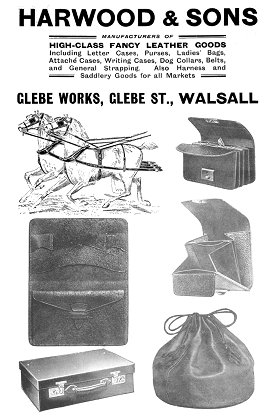 |
|
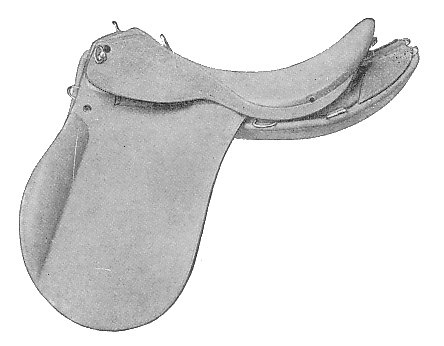
A Stone & Roberts saddle. |
Stone & Roberts of 43 Wednesbury Road
were a well known manufacturer of high class saddlery.
The firm designed and made saddles for
military and other purposes, suitable for all climates.
The saddles were sold at home and
abroad, many going to
India, Australia, and New Zealand.
|
 |
|
 |
|
More adverts
from 1974. |
|
|

Finishing pig skin leather, ready for
export. |
Today’s manufacturers include E. Hulme
& Son Limited, the largest manufacturer of small leather
promotional and advertising gifts in the country, Peter
Yates Leathergoods Limited, manufacturers and importers of
leather, and producers of a range of products including
conference folders, travel wallets, and business accessories.
Ancol make collars and leads for pet owners, using the best
bridle leather, and Nevada leather goods produce the
extensive Abbeygate collection of promotional diaries and
striking leather gifts.
W. Lees (Walsall) Limited is an
established manufacturer of men's leather belts, and braces,
serving both the wholesale and retail trade. |
|
Jabez Cliff and Company
The firm, which became one of Walsall’s
most successful, and longest surviving saddle makers was
founded by Jabez Cliff, whose father George began his
apprenticeship at a Walsall saddlery company in 1793. George
lived with his father George senior, his mother Elizabeth,
three brothers, and a sister in Badger’s Yard in Park Street
where George senior made leather breeches in a small
workshop behind his home. George began his apprenticeship at
the age of 13 and learned how to make bridles.
George later married and had several
children, all except one dying young. The surviving son
Jabez started his own saddlery business in 1873 when he
founded Jabez Cliff and Company, in Portland Street,
Walsall. Eight years later tragedy struck when Jabez and his
two sons Samuel and George died in the terrible typhoid
epidemic that swept across the country. Luckily his wife and
daughter Mary managed to keep the business going. In 1882
Mary married Frederick Tibbits, a skilled bridlemaker who
joined them in the firm.
In 1902 their son Jabez Cliff Tibbits
joined the firm. In 1906 he purchased J. A. Barnsby and
Sons, saddle makers at Globe Works in Lower Forster Street.
The two firms amalgamated and produced saddles under the
Barnsby name, bridleware under the Cliff name, and created
the saddlery brand of Cliff-Barnsby. |
|
The firm exported many of its products
to Russia and Germany, but as the First World War loomed,
Jabez realised that other markets, and other products had to
be found. The firm them diversified into the production of
sports products and leather goods, including cricket balls,
soft-balls, golf bags, holdalls, leather cases and travel
goods.
The firm developed and patented a
none-tear football which came to fame in four FA cup finals,
and in the 1928 Olympic Games.
In 1929 the firm exhibited basket
balls, cricket balls, footballs, hockey balls, polo balls,
tennis balls, volley balls, bowl bags, golf bags, sports
bags, belts, dog collars, riding saddlery, and travelling
requisites at the British Industries Fair.
The company’s managing director Jabez
Cliff Tibbits served on Walsall Council for Hatherton Ward.
He was elected Lord Mayor of Walsall in 1939 and 1940, and
became an Alderman in 1941. He also became a Justice of the
Peace. |
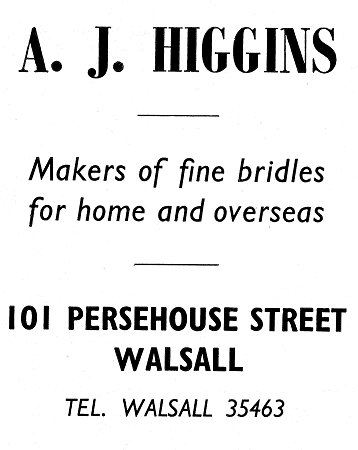
An advert from 1974. |
|
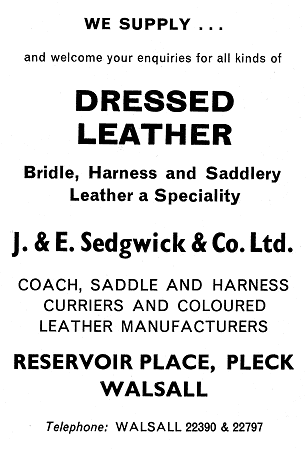
An advert from 1974. |
During the Second World War the firm produced Bren gun
pouches, webbing, and ammunition belts, and formed links
with the military that would continue for years to come.
The firm’s display at the 1947 British Industries Fair
included Barnsby saddles, bridles, reins, head collars,
Globe footballs, baseball balls, cricket balls, hockey
balls, netball balls, rounders balls, water polo balls,
leather travel goods, golf bags, and sports bags.
In 1948 Jabez Cliff Tibbits, who lived
at Cedar Court in Aldridge was knighted by King George VI
for his services to Walsall, and became known as `Sir
Cliff`. He died in 1974.
During the Falklands War in the early
1980s the firm supplied the task forces with pack saddlery
so that vital weapons and equipment could be transported by
mules. For this work the queen awarded a Royal Warrant as
Saddler and Loriner to the firm, which also supplied
saddlery equipment to the Kings Troop, the Royal Horse
Artillery, the Household Cavalry, the Metropolitan Police,
the City of London Police, and also ceremonial equipment to
countries throughout the world. |
|
The firm became one of the top five
saddlery businesses in the world, exporting saddles and
leather goods to many countries. In 2009 Jabez Cliff &
Company Limited moved from Globe Works to new premises in
Aldridge Road. It was the start of a new era. The buildings
were officially opened by HRH the Princess Royal on Tuesday
21st September 2010, and the future looked bright. The firm
was then to be known as Barnsby, and the new buildings were
called Badgers Yard.
In August 2011 tragedy struck at the
firm’s old premises in Lower Forster Street which were
destroyed by fire. The building had been earmarked to become
a £3m health centre with two doctors’ surgeries, an optician
and a pharmacy.
Barnsby concentrated on sporting goods,
saddlery and other fine leather goods, much of which was
exported to the USA, Western Europe, the Far East, Africa,
the Middle East, Australia and the Pacific Rim.
|
|

Using a
leather cutting machine. |
The firm’s saddlery was used by many of the leading professional
riders, but by the beginning of 2014 things had started to
go wrong. Seven people were made redundant from the sales
department, the office, the factory and the warehouse, but
the firm remained confident that profits would soon
increase.
The company’s creditors agreed to
reduce their debts to manageable levels, and everyone worked
hard to increase sales, but the bottom had fallen out of the
market.
On 17th June, 2014 the Birmingham Post
reported that Barnsby has ceased trading due to a failed
restructure and has gone into administration. The remaining
twenty six staff were made redundant, and Andy McGill,
partner at the Birmingham office of Smith & Williamson, was
appointed as administrator. A very sad end to an old and
well-respected firm, whose future had seemed so bright only
a few years earlier. |
|

Sewing fancy
leather goods. Courtesy of John and Christine Ashmore. |
|
Saddle makers include King's Saddlery,
which is famous across the equestrian world, and Albion
saddle makers who make a range of high quality products for
horse owners.
Another saddle maker is E. Jeffries & Sons Limited in
Bridgeman Street. The business was founded in 1820 and has
become a well known name in the horse world. The firm
designs and manufactures saddlery, bridlework, and riding
equipment using the latest technology and materials combined
with traditional manufacturing skills and craftsmanship.
High quality leather is still produced
in the town. J & E Sedgwick & Company Limited was founded in
1900 by James and Emmanuel Sedgwick, who were later joined
by Richard Farrow.
The company is one of the leading
suppliers of equestrian leather in Walsall and maintains an
active recruitment and training programme for new young
apprentices. |

Examples of Walsall-made spurs. |
|
Messrs.
John Dewsbury & Son, Bridle Bit and Nickel
Plating Works, Littleton Street
A visit in 1897 by members of the
Institution of Mechanical Engineers
These works were
founded by the late Mr. John Dewsbury in
1840 in Duncalf Street, Walsall, and the
increasing business was soon afterwards
removed to Littleton Street. Here bridle
bits are produced in all qualities, sizes,
and patterns; among the novelties are bits
made with India rubber mouthpieces for
tender mouthed horses, the chains inside
being tested to stand a pull of 500 lbs.;
and medicine drenching bits, by which
medicine may be easily given to horses and
cows.
Besides the usual
japanned, tinned, and nickel plated goods,
bits in solid nickel silver are extensively
made. In the new nickel plating process
steel articles are placed in a perforated
cage, through which runs a brass rod
connected electrically by its bearings with
the rods that suspend it; the cage is spun
in the green solution of nickel, and as the
articles jolt about inside they take on the
metal and polish themselves against one
another. Some bits are cast, but most are
forged; and skilful work is required to
snake the two halves of a light snaffle
exactly alike. For making rings, a rod of
steel is drawn from the forge, twisted
round, run through a hole, welded, and
moulded to shape with a few blows on a plug;
the extra metal at the joint is removed by a
file.
The first polishing
takes place in revolving cans amid sand and
water or emery and oil; the last is
performed on calico wheels with tripoli
rubbed on from the cake. An interesting
process is the making of moulds from the
drawings. A piece of lead is carved to
resemble the drawing as nearly as possible,
from which a mould is taken in sand, and a
casting made; the latter is then carved
until it truly represents the drawing, and
is then moulded, and another casting taken
from it, which becomes the lead pattern for
future use. The number of workpeople
employed is 100. |
|
|
In 1971 the old established firm, Boak
Currying Company Limited, was acquired by James Garnar &
Sons Limited of London. The name of the company was then
changed to Garnar Boak Limited. Mr. R. G. A. Boak continued
as Managing Director, and new machinery and working methods
were introduced to increase production.
This enabled the business to extend its
market share, particularly abroad. The high quality products
include pigskin leather, hide, E.I. Kips and calf leather
which is ideally suited for the production of saddlery,
bridle, and fancy goods.
|
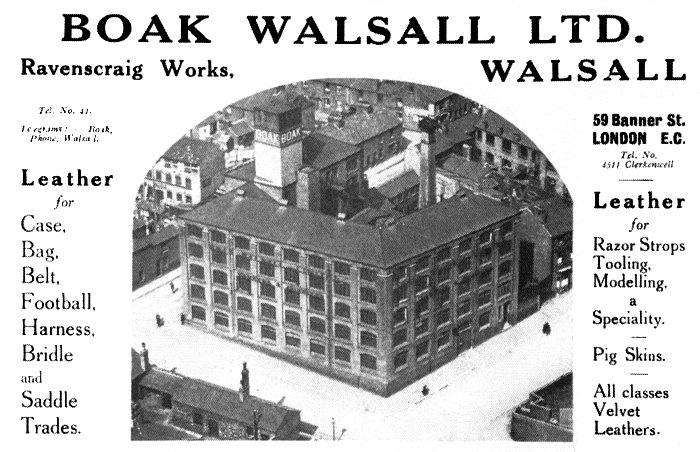
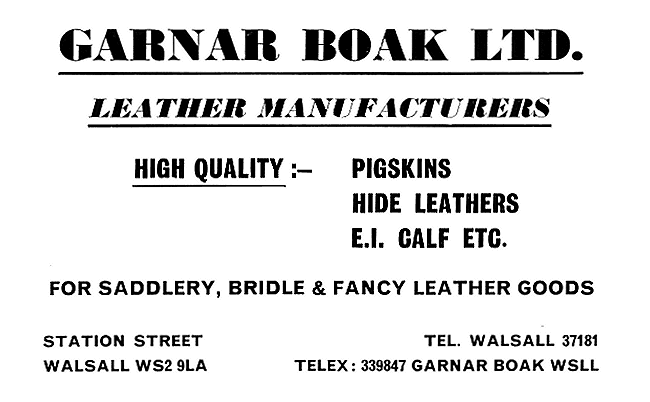

Garnar Boak Limited's factory can
be seen on the left of Bridgeman Street, with the Anchor
pub on the right. Sadly the factory was destroyed a few
years ago after a mindless arson attack. Taken by
Richard Ashmore. Courtesy of John & Christine Ashmore. |
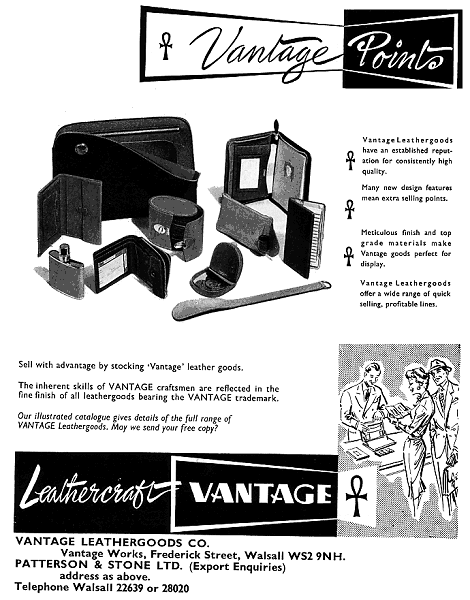 |
Another successful business, the
Vantage Leathergoods Company, founded in 1899, manufactures
a wide range of leather products from many types of leather.
The products, which carry the 'Vantage' trade mark, include
ashtrays, billfolds, folio cases, brushes and brush sets,
pocket flasks, key purses, manicure sets, notecases,
shoe-shine kits, spectacle cases, stud boxes, tobacco
pouches, travel slippers, wallets, wet packs, and writing
cases. |
|

Invoice letterhead from the
1960s, from Butler Brothers, leather supplies. |
| Specialities (Leather) Limited, founded just before
the First World War, produced a range of purses,
wallets, tobacco pouches, and shopping bags, etc. that
were sold both at home and abroad. They also produced a
range of novelty goods under the name of "St. Crispin".
The firm initially had premises in Bridge Street,
Walsall, but due to early growth larger premises were
soon required and so the firm moved to Stafford, where
it stayed for some time. Several years later a new
purpose-built factory was erected at Goscote where goods
were made on a conveyor belt system, the first time this
technique had been used in the leather trade. All went
well until the Second World War when the factory was
requisitioned. In order to carry-on with production of
fancy leather goods, the firm used other factories, some
as far away as London. Although recovery was difficult
after the war, the company prospered, soon producing a
range of over two hundred items at four sites in
Walsall, including a wide range of shopping bags.
|
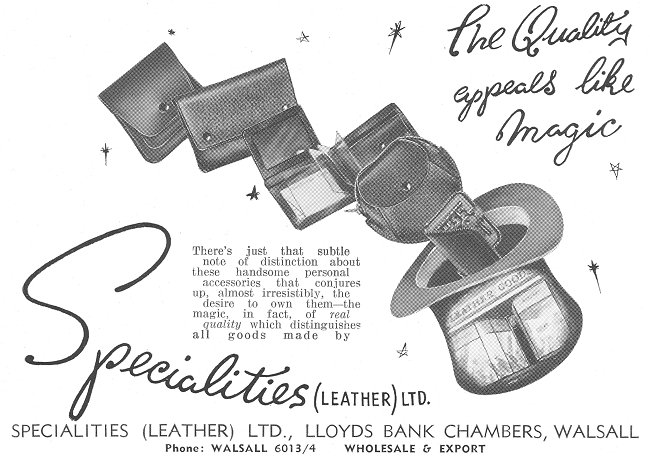
An advert from 1954.
| |
|
| Read about Joseph Carver's
firm which produced whips, then moved into engineering |
 |
| |
|
 |
Return to
Walsall Industries |
|